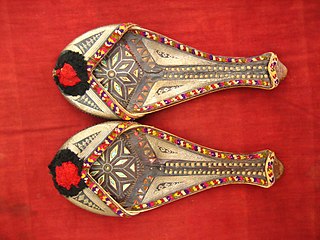 W
WThe Culture of Sindh has its roots in the Indus Valley Civilization. Sindh has been shaped by the largely desert region, the natural resources it had available, and continuous foreign influence. The Indus or Sindhu River that passes through the land, and the Arabian Sea also supported the seafaring traditions among the local people. The local climate also reflects why the Sindhis have the language, folklore, traditions, customs and lifestyle that are so different from the neighboring regions. The Sindhi culture is also practiced by the Sindhi diaspora.
 W
WAjrak, also known as Ajrakh, is a unique form of blockprinting found mostly in Sindh, Pakistan and Ajrakhpur, Kutch district, India. These shawls display special designs and patterns made using block printing by stamps. Over the years, ajraks have become a symbol of the Sindhi culture and traditions. Ajrak print is also famous in neighbouring areas of India in the state of Gujarat due to their influence from Indus Valley Civilization in Sindh, Pakistan. A similar ajrak type of shawl, Sajarak is found in South Punjab of Pakistan. Sajarak is mostly of cyan color while the simple Ajrak is of red and black.
 W
WThe Brahma from Mirpur Khas is a famous bronze image of Brahma made in Sindh, in modern Pakistan, dated to the 5th or 6th century, during the Gupta period. It is the earliest known metallic image of Brahma and the only known representative of the school it represents. It has been described as "an immense artistic creation" of the Gupta period.
 W
WCheti Chand is a festival that marks the beginning of the Lunar Hindu New Year for Sindhi Hindus. The date of the festival is based on the lunar cycle of the lunisolar Hindu calendar, falling on the first day of the year, in the Sindhi month of Chet (Chaitra). It typically falls in late March or early April in the Gregorian calendar on or about the same day as Gudi Padwa in Maharashtra and Ugadi in other parts of the Deccan region of India.
 W
WWatayo Faqir is a legendary character from Sindh, Pakistan. Many fables based on his wisdom and philosophy that are widely spread, and are told at "Kachehris" and are told to children in Sindhi Folklore. At the age of 75, he is said to have died and buried at Tando Allahyar.
 W
WThe Indian Institute of Sindhology (I.I.S.) is a center for advanced studies and research in the fields related to Sindhi language, literature, education, art and culture. Its primary aim is to preserve and promote the cultural heritage of Sindhi Community and ensure its continuity by disseminating it in the younger generation.
 W
WLal Loi is the Sindhi name for the festival of Lohri. Prior to the Partition of India in 1947, Lal Loi was celebrated in some parts of Sindh. On the day of Lal Loi children brought wood sticks from their grand parents and aunties and lit a fire burning the sticks in the night with people enjoying, dancing and playing around the fire.
 W
WRalli quilts are traditional quilts with appliqué and patchwork handmade by women artisans of Sindh's remote areas. The craft belongs to Sindh Pakistan, western India, and surrounding areas. Embroidery designs and motifs indicate perceived on painted pottery from the area's ancient civilizations. Mothers used to explain several inheritance patterns to their daughters. The quilt made with the same was called Rilli or Ralli quilt.
 W
WThe Sindhi cap, also known as the Sindhī ṭopī, is a skullcap worn predominantly by Sindhis in Sindh, Pakistan. Together with Ajrak or Saraiki Ajrak, the Sindhi cap is regarded as an essential part of Sindhi and Saraiki culture.
 W
WSindhi women wear the Ghagra Choli or the sari and the men wear the shalwar kameez or the kurta with pyjamma. However, before the adoption of the Shalwar kameez, the sari and the kurta, Sindhi's had their own traditional costumes.
 W
WSindhi Cultural Day, is a popular Sindhi Cultural festival, also known as 'Aekta Jo Dihaarro', is widely celebrated with traditional enthusiasm to spotlight the centuries-old rich culture of Sindh. The day is celebrated all over Sindh, and amongst the Sindhi diaspora around the world. Cultural day is the celebration, demonstration of culture of Sindh, Sindhis in Sindh and Sindhi diaspora all over the world celebrate this day to demonstrate the peaceful identity of Sindhi culture and acquire the attention of the world towards the rich heritage and culture of Sindh.
 W
WSindhi Mojari is a type of handcrafted footwear produced in Pakistan. They are traditionally made by artisans mostly using tanned leather. The uppers are made of one piece of leather or textile embroidered and embellished with brass nails, cowry shells, mirrors, bells and ceramic beads. Even the bonding from the upper to the sole is done by cotton thread that is not only eco-friendly but also enmeshes the leather fibers with great strength. Some product range also uses bright and ornate threads.
 W
WSindhi poetry continues an oral tradition dating back a thousand years. The verbal verses were based on folk tales. Sindhi is one of the major oldest languages of the Indus Valley having a peculiar literary colour both in poetry and prose. Sindhi poetry is very rich in thought as well as contain variety of genres like other developed languages. Old Sindhi poetry impacts upon contemporary languages and also accepts the healthy influence of some languages like Hindi. Sindhi poetry contains two main original forms of verse, such as bait and Waei. Bait slightly resembles with form Dohas and Sorthas, moreover also influenced by Persian forms like Ghazal, Mathnavi, Rubai, and Kaafi. Since the 1940s, Sindhi poetry has incorporated broader influences including the sonnet and blank verse. Soon after the independence of Pakistan in 1947, these forms were reinforced by Triolet, Haiku, Renga and Tanka etc. At present, these forms continue to co-exist, albeit in a varying degree, with Azad Nazm having an edge over them all.